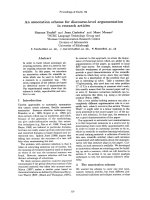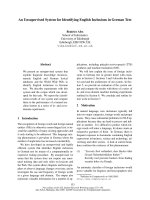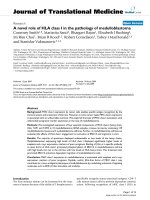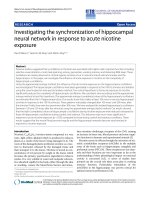Báo cáo hóa học: " AN EXPLICIT CONSTRUCTION OF SUNNY NONEXPANSIVE RETRACTIONS IN BANACH SPACES" doc
Bạn đang xem bản rút gọn của tài liệu. Xem và tải ngay bản đầy đủ của tài liệu tại đây (520.17 KB, 11 trang )
AN EXPLICIT CONSTRUCTION OF SUNNY NONEXPANSIVE
RETRACTIONS IN BANACH SPACES
ARKADY ALEYNER AND SIMEON REICH
Received 22 March 2005
An explicit algorithmic scheme for constructing the unique sunny nonexpansive retrac-
tion onto the common fixed point set of a nonlinear semigroup of nonexpansive map-
pings in a Banach space is analyzed and a proof of convergence is given.
1. Introduction
Throughout this paper all vector spaces are real and we denote by N and R
+
the set
of nonnegative integers and nonnegative real numbers, respectively. Let (X,·)bea
Banach space and let X
∗
be its dual. The value of y ∈ X
∗
at x ∈ X will be denoted by
x, y. We also denote by J : X → 2
X
∗
the normalized duality map from X into the family
of nonempty (by the Hahn-Banach theorem) weak-star compact convex subsets of X
∗
,
whichisdefinedbyJx ={x
∗
∈ X
∗
: x,x
∗
=x
2
=x
∗
2
} for all x ∈ X.TheBanach
space X is said to be smooth or to have a G
ˆ
ateaux differentiable nor m if the limit
lim
t→0
x + ty−x
t
(1.1)
exists for each x, y ∈ X with x=y=1. The space X is said to have a unifor m ly
G
ˆ
ateaux differentiable norm if, for each y ∈ X with y=1, the limit (1.1)isattained
uniformly in x ∈ X with x=1. It is known [12, Lemma 2.2] that if the norm of X
is uniformly G
ˆ
ateaux differentiable, then the duality map is single-valued and norm to
weak star uniformly continuous on each bounded subset of X.LetC be a nonempt y,
closed and convex subset of X and E be a nonempty subset of C.AmappingQ : C
→ X
is nonexpansive if Qx − Qy≤x − y for all x, y ∈ C.AmappingQ : C → E is called a
retraction from C onto E if Qx = x for all x ∈ E.AretractionQ from C onto E is called
sunny if Q has the following property: Q(Qx + t(x − Qx)) = Qx for all x ∈ C and t ≥ 0
with Qx + t(x − Qx) ∈ C.Itisknown[6, Lemma 13.1] that in a smooth Banach space X,
aretractionQ from C onto E is both sunny and nonexpansive if and only if
x − Qx,J(y − Qx)
≤ 0 (1.2)
for all x ∈ C and y ∈ E. Hence, there is at most one sunny nonexpansive retraction from
C onto E.Forexample,ifE is a nonempty, closed and convex subset of a Hilbert space
Copyright © 2005 Hindawi Publishing Corporation
Fixed Point Theory and Applications 2005:3 (2005) 295–305
DOI: 10.1155/FPTA.2005.295
296 Sunny nonexpansive retractions
H, then the nearest point projection P
E
from H onto E is the unique sunny nonexpan-
sive retraction of H onto E. This is not true for all Banach spaces, since outside Hilbert
space, nearest point projections, although sunny, are no longer nonexpansive. On the
other hand, sunny nonexpansive retractions do sometimes play a similar role in Banach
spaces to that of nearest point projections in a Hilbert space. So an interesting problem
arises: for which subsets of a Banach space does a sunny nonexpansive retraction exist?
If it does exist, how can one find it? It is known [6, Theorem 13.2] that if C is a closed
convex subset of a uniformly smooth Banach space and T : C → C is nonexpansive, then
the fixed point set of T is a sunny nonexpansive retract of C. More generally, Bruck [3 ,
Theorem 2] proves that if C is a closed convex subset of a reflexive Banach space every
bounded, closed and convex subset of which has the fixed point property for nonexpan-
sive mappings and T : C → C is nonexpansive, then its fixed point set is a nonexpansive
retract of C. (It is still an open question w hether all bounded, closed and convex subsets
of reflexive Banach spaces have this fixed point property.) For a weak sufficient condi-
tion on the underlying space which guarantees that nonexpansive retracts are, in fact,
sunny nonexpansive retracts see [10, Theorem 4.1]. In the present paper we show that if
F is the nonempty common fixed point set of a commuting family of nonexpansive self-
mappings of closed convex subsets C of certain Banach spaces X, satisfying an asymptotic
regularity condition, then it is possible to construct the sunny nonexpansive retraction Q
of C onto F in an explicit iterative way. The origin of our work lies in a recent publication
by Dom
´
ınguez Benavides, L
´
opez Acedo and Xu [5] who attempted to construct sunny
nonexpansive retractions using both implicit and explicit iterative schemes (cf. the dis-
cussion in [1]). Our work improves, corrects and generalizes some of the results obtained
in the above paper. It is also related to a result of Reich [11], where the case of a single
mapping is dealt with. In this connection we would also like to refer the interested reader
to the results obtained by Suzuki [14] who deals with an implicit scheme for construct-
ing the sunny nonexpansive retraction onto the common fixed point set of some one-
parameter semigroups of nonexpansive mappings. For related results in Hilbert space see
Aleyner and Censor [1], Bauschke [2], Deutsch and Yamada [4], Halpern [7], Lions [8],
and Wittmann [15].
2. Preliminaries and notations
Let l
∞
denote the real Banach space of all bounded sequences a = (a
1
,a
2
, ) w ith the
norm defined by a=sup
n
|a
n
|. A continuous linear functional LIM on l
∞
is called a
Banach limit when LIM satisfies LIM(a) ≥ 0ifa
n
≥ 0, n = 1,2, ,LIM({a
n
}) =
LIM({a
n+1
})and LIM=LIM(1) = 1. To prove our theorem, we need the following
two propositions [13, Propositions 1 and 2], which can be deduced from the arguments
in the proof of [9, Theorem 1]. We sketch their proofs for the sake of completeness.
Proposition 2.1. Let α be a real number and let a
= (a
1
,a
2
, ) ∈ l
∞
. Then LIM(a) ≤ α
for all Banach limits LIM if and only if for each ε>0,thereexistsn
0
∈ N such that
a
k
+ a
k+1
+ ···+ a
k+n−1
n
<α+ ε (2.1)
for all n ≥ n
0
and k ∈ N.
A. Aleyner and S. Reich 297
Proof. First we prove the necessity of (2.1). Assume LIM(a) ≤ α for all Banach limits LIM.
Define a sublinear functional β from l
∞
into the real line R by
β
b
1
,b
2
,
=
limsup
n→∞
sup
k∈N
1
n
k+n−1
i=k
b
i
, (2.2)
where (b
1
,b
2
, ) ∈ l
∞
. By the Hahn-Banach theorem, there exists a linear functional µ
from l
∞
into R such that µ ≤ β and µ(a) = β(a). It is not difficult to see that µ is a Banach
limit. Since µ(a) ≤ α, there exists, for each ε>0, a natural number n
0
∈ N which satisfies
(2.1). Next we prove that (2.1)issufficient. Let µ beaBanachlimitandletε>0. By the
hypothesis, there exists n
0
such that (2.1) is satisfied. Hence we have
µ(a) = µ
a
k
+ a
k+1
+ ···+a
k+n
0
−1
n
0
≤ α + ε. (2.3)
Since ε is an arbitrary positive number, we see that µ(a) ≤ α.
Proposition 2.2. Le t α be a real number and let a = (a
1
,a
2
, ) ∈ l
∞
be such that
LIM(a) ≤ α (2.4)
for all Banach limits LIM, and
limsup
n→∞
(a
n+1
− a
n
) ≤ 0. (2.5)
Then
limsup
n→∞
a
n
≤ α. (2.6)
Proof. Let ε>0. By Proposition 2.1, there exists n ≥ 2suchthat
a
k
+ a
k+1
+ ···+ a
k+n−1
n
<α+
ε
2
(2.7)
for all k ∈ N.Choosek
0
∈ N such that a
k+1
− a
k
<ε/(n − 1) for all k ≥ k
0
.Letk ≥ k
0
+ n.
Then we have
a
k
= a
k−i
+
a
k−i+1
− a
k−i
+
a
k−i+2
− a
k−i+1
+ ···+
a
k
− a
k−1
≤ a
k−i
+
iε
n − 1
(2.8)
for each i = 0,1,2, ,n − 1. So we obtain
a
k
≤
a
k
+ a
k−1
+ ···+ a
k−n+1
n
+
1
n
·
n(n − 1)
2
·
ε
n − 1
≤ α + ε. (2.9)
Hence we have
limsup
k→∞
a
k
≤ α + ε. (2.10)
Since ε is an arbitrary positive number, the proposition is proved.
298 Sunny nonexpansive retractions
3. Convergence theorem
Let X be a Banach space, C a nonempty, closed and convex subset of X, G an unbounded
subset of R
+
such that
t + h ∈ G ∀t,h ∈ G,
t − h ∈ G ∀t,h ∈ G with t ≥ h,
(3.1)
and Γ ={T
t
: t ∈ G} a family of nonexpansive self-mappings of C such that the set F of
the common fixed points of Γ is nonempty. We make the following assumptions.
Assumptions on the space. X is a reflexive Banach space with a uniformly G
ˆ
ateaux dif-
ferentiable norm such that each nonempty, bounded, closed and convex subset K of X
has the common fixed point property for nonexpansive mappings; that is, any family of
commuting nonexpansive self-mappings of K has a common fixed point. Note that all
these assumptions are fulfilled whenever X is uniformly smooth.
Assumptions on the mappings. Γ is a uniformly asymptotically regular semigroup on
bounded subsets of C, that is,
T
s+t
x = T
s
T
t
x (3.2)
for all t,s ∈ G, x ∈ C, and for all bounded subsets K of C there holds
lim
r→∞
sup
K
T
s
T
r
x − T
r
x
= 0, (3.3)
uniformly for all s ∈ G. Note that both these assumptions hold when the trajectories of
the semigroup Γ converge uniformly on bounded subsets of X.
Assumptions on the parameters. {λ
n
} is a sequence of numbers in [0,1) with the following
properties:
λ
n
−→ 0, (3.4)
∞
n=0
1 − λ
n
=
0; equivalently,
∞
n=0
λ
n
=∞, (3.5)
∞
n=0
λ
n+1
− λ
n
< ∞. (3.6)
Observe that given points f ∈ F, u,x
0
∈ C, and the bounded subset D ={x ∈ C : x −
f ≤max(x
0
− f ,u − f )}, there exists a sequence {r
n
}⊆G such that
r
0
<r
1
<r
2
< ··· <r
n
< ··· ,lim
n→∞
r
n
=∞, (3.7)
∞
n=0
sup
D
T
s
T
r
n
x − T
r
n
x
< ∞, (3.8)
uniformly for all s ∈ G. We now define the sequence {x
n
} by
x
n+1
= λ
n
u +
1 − λ
n
T
r
n
x
n
, (3.9)
where n ≥ 0; we say that {x
n
} has anchor u and initial point x
0
.
A. Aleyner and S. Reich 299
Theorem 3.1. If the above assumptions on the space, mappings and parameters hold, then
thesequencegeneratedby(3.9)convergesinnormtoQu,whereQ is the unique sunny non-
expansive retraction from C onto F.
Proof. We first prove the result for the special case x
0
= u and then extend it to the general
case. We div ide our proof into a sequence of separate claims.
Claim 3.2. For all n ≥ 0andevery f ∈ F,
x
n
− f
≤u − f . (3.10)
We proceed by induction on n.Fix f ∈ F.Clearly,(3.10)holdsforn = 0. If x
n
− f ≤
u − f ,then
x
n+1
− f
≤ λ
n
u − f +
1 − λ
n
T
r
n
x
n
− f
≤ λ
n
u − f +
1 − λ
n
x
n
− f
≤u − f ,
(3.11)
as required.
Claim 3.3. The following strong convergence holds:
x
n+1
− T
r
n
x
n
−→ 0. (3.12)
This is true because (3.10) guarantees that
{x
n
} is bounded, which, in tur n, implies that
{T
r
n
x
n
} is also bounded. The boundedness of {T
r
n
x
n
} together with (3.4)imply,inview
of (3.9), our assert ion.
Claim 3.4. The differences of consecutive iterates strongly converge to zero, namely,
x
n+1
− x
n
−→ 0. (3.13)
Indeed, it follows from (3.10)thatx
n
∈ D for all n ≥ 0. By the boundedness of {x
n
} and
{T
r
n
x
n
} there exists some constant L ≥ 0suchthatx
n+1
− x
n
≤L and u − T
r
n
x
n
≤L
for all n ≥ 0. Therefore, for all n ≥ 1weget
x
n+1
− x
n
=
λ
n
− λ
n−1
u − T
r
n−1
x
n−1
+
1 − λ
n
T
r
n
x
n
− T
r
n−1
x
n−1
≤
λ
n
− λ
n−1
u − T
r
n−1
x
n−1
+
1 − λ
n
T
r
n
x
n
− T
r
n
x
n−1
+
1 − λ
n
T
r
n
x
n−1
− T
r
n−1
x
n−1
≤
λ
n
− λ
n−1
u − T
r
n−1
x
n−1
+
1 − λ
n
x
n
− x
n−1
+
T
r
n
x
n−1
− T
r
n−1
x
n−1
≤
λ
n
− λ
n−1
L +
1 − λ
n
x
n
− x
n−1
+
T
r
n
x
n−1
− T
r
n−1
x
n−1
.
(3.14)
300 Sunny nonexpansive retractions
Since Γ is a semig roup, we are able to rewrite the last term as follows:
T
r
n
x
n−1
− T
r
n−1
x
n−1
=
T
r
n
−r
n−1
T
r
n−1
x
n−1
− T
r
n−1
x
n−1
. (3.15)
Thus
x
n+1
− x
n
≤
λ
n
− λ
n−1
L +
1 − λ
n
x
n
− x
n−1
+
T
r
n
−r
n−1
T
r
n−1
x
n−1
− T
r
n−1
x
n−1
(3.16)
for all n ≥ 1. Hence, inductively,
x
n+1
− x
n
≤ L
n
k=m
λ
k
− λ
k−1
+
x
m
− x
m−1
n
k=m
1 − λ
k
+
n
k=m
T
r
k
−r
k−1
T
r
k−1
x
k−1
− T
r
k−1
x
k−1
,
(3.17)
for all n ≥ m ≥ 1. Taking now the limit as n tends to +∞,weobtain
limsup
n→∞
x
n+1
− x
n
≤ L
∞
k=m
λ
k
− λ
k−1
+ L
∞
k=m
1 − λ
k
+
∞
k=m
sup
D
T
r
k
−r
k−1
T
r
k−1
x − T
r
k−1
x
= L
∞
k=m
λ
k
− λ
k−1
+
∞
k=m
sup
D
T
r
k
−r
k−1
T
r
k−1
x − T
r
k−1
x
(3.18)
by (3.5). On the other hand, conditions (3.6)and(3.8)implythat
lim
m→∞
∞
k=m
λ
k
− λ
k−1
=
0,
lim
m→∞
∞
k=m
sup
D
T
r
k
−r
k−1
T
r
k−1
x − T
r
k−1
x
=
0.
(3.19)
Altogether, by letting m tend to ∞,weconcludethatx
n+1
− x
n
→ 0, as claimed.
Claim 3.5. For each fixed s ∈ G,
T
s
x
n
− x
n
−→ 0. (3.20)
Indeed, let s ∈ G.Then
T
s
x
n
− x
n
≤
T
s
x
n
− T
s
T
r
n
x
n
+
T
s
T
r
n
x
n
− T
r
n
x
n
+
T
r
n
x
n
− x
n
≤
2
x
n
− T
r
n
x
n
+sup
D
T
s
T
r
n
x − T
r
n
x
≤ 2
x
n
− x
n+1
+
x
n+1
− T
r
n
x
n
+sup
D
T
s
T
r
n
x − T
r
n
x
.
(3.21)
Combining (3.12), (3.13), and (3.8), we see that T
s
x
n
− x
n
→ 0, as asserted.
A. Aleyner and S. Reich 301
Let LIM be a Banach limit and let {α
s
}
s∈G
be a net in the interval (0,1) such that
lim
s→∞
α
s
= 0. By Banach’s fixed point theorem, for each s ∈ G, t here exists a unique point
z
s
∈ C satisfying the equation z
s
= α
s
u +(1− α
s
)T
s
z
s
. Since the following claim is essen-
tially proved in [5], we include only a sketch of its proof.
Claim 3.6.
z
s
−→ Qu, (3.22)
where Q : C
→ F is the unique sunny nonexpansive retraction from C onto F.
Indeed, let {s
n
} be a subsequence of G such that lim
n→∞
s
n
=∞.Since{z
s
n
} is bounded,
we can define a functional g on C by
g(x) = LIM
z
s
n
− x
2
. (3.23)
We have for ea ch r
∈ G,
g
T
r
x
=
LIM
z
s
n
− T
r
x
2
=
LIM
T
r
T
s
n
z
s
n
− T
r
x
2
≤ LIM
T
s
n
z
s
n
− x
2
=
LIM
z
s
n
− x
2
,
(3.24)
by (3.3). In other words,
g
T
r
x
≤ g(x) (3.25)
for all r ∈ G and x ∈ C.LetK ={x ∈ C : g(x) = min
C
g}.Sinceg is convex and continu-
ous, lim
x→∞
g(x) =∞and X is reflexive, K is a nonempty, closed, bounded and convex
subset of C.From(3.25)weseethatK is invariant under each T
r
; that is, T
r
(K) ⊂ K,
r ∈ G.HenceK contains a common fixed point of Γ.Letq ∈ K
F be such a common
fixed point. Since q is a minimizer of g over C, it follows that for each x ∈ C,
0
≤ lim
λ→0
+
1
λ
g
q + λ(x − q)
− g(q)
=
LIM
lim
λ→0
+
1
λ
z
s
n
− q
+ λ(q − x)
2
−
z
s
n
− q
2
=
LIM
2
q − x,J
z
s
n
− q
.
(3.26)
Thus,
LIM
x − q, J
z
s
n
− q
≤ 0 (3.27)
for all x ∈ C. On the other hand, for any f ∈ F,
z
s
n
− f =
1 − α
s
n
T
s
n
z
s
n
− f
+ α
s
n
(u − f ). (3.28)
302 Sunny nonexpansive retractions
It follows that
z
s
n
− f
2
=
1 − α
s
n
T
s
n
z
s
n
− f ,J
z
s
n
− f
+ α
s
n
u − f ,J
z
s
n
− f
≤
1 − α
s
n
z
s
n
− f
2
+ α
s
n
u − f ,J
z
s
n
− f
.
(3.29)
Hence
z
s
n
− f
2
≤
u − f ,J
z
s
n
− f
. (3.30)
Combining (3.27)and(3.30), we get
LIM
z
s
n
− q
2
≤ 0. (3.31)
Hence there is a subsequence {z
r
j
} of {z
s
n
} such that lim
j→∞
z
r
j
− q=0. Assume that
there exists another subsequence {z
p
k
} of {z
s
n
} such that lim
k→∞
z
p
k
−
˜
q=0, where
˜
q ∈ K
F.Then(3.30) implies that
q −
˜
q
2
≤
u −
˜
q,J
q −
˜
q
. (3.32)
Similarly we have
˜
q − q
2
≤
u − q,J
˜
q − q
. (3.33)
Adding up (3.32)and(3.33)weobtainq
=
˜
q. Therefore {z
s
} converges in norm to a point
in F.NowwedefineQ : C → F by Qu = lim
s→∞
z
s
.ThenQ is a retraction from C onto F.
Moreover, by (3.30)wegetforall f ∈ F,
Qu − f
2
≤
u − f ,J(Qu − f )
. (3.34)
That is,
u − Qu,J( f − Qu)
≤ 0 (3.35)
for all f ∈ F. Therefore Q is the unique sunny nonexpansive retraction from C onto F
(see (1.2)).
Claim 3.7.
limsup
n→∞
u − Qu,J
x
n
− Qu
≤ 0. (3.36)
Since T
s
is nonexpansive, (3.20) implies that
LIM
x
n
− T
s
z
s
2
= LIM
T
s
x
n
− T
s
z
s
2
≤ LIM
x
n
− z
s
2
. (3.37)
A. Aleyner and S. Reich 303
Since (1 − α
s
)(x
n
− T
s
z
s
) = (x
n
− z
s
) − α
s
(x
n
− u), we have
1 − α
s
2
x
n
− T
s
z
s
2
≥
x
n
− z
s
2
− 2α
s
x
n
− u,J
x
n
− z
s
=
x
n
− z
s
2
− 2α
s
x
n
− z
s
+ z
s
− u,J
x
n
− z
s
=
x
n
− z
s
2
− 2α
s
x
n
− z
s
,J
x
n
− z
s
− 2α
s
z
s
− u,J
x
n
− z
s
=
1 − 2α
s
x
n
− z
s
2
+2α
s
u − z
s
,J
x
n
− z
s
.
(3.38)
Therefore
1 − α
s
2
LIM
x
n
− z
s
2
≥
1 − 2α
s
LIM
x
n
− z
s
2
+2α
s
LIM
u − z
s
,J
x
n
− z
s
(3.39)
for each n ≥ 0. These inequalities yield
α
s
2
LIM
x
n
− z
s
2
≥ LIM
u − z
s
,J
x
n
− z
s
. (3.40)
Since
u − z
s
,J
x
n
− z
s
−
u − Qu,J
x
n
− Qu
=
u − z
s
− (u − Qu),J
x
n
− z
s
+
u − Qu,J
x
n
− z
s
− J
x
n
− Qu
,
(3.41)
we obtain by letting s tend to ∞ that
0 ≥ LIM
u − Qu,J
x
n
− Qu
(3.42)
because X hasauniformlyG
ˆ
ateaux differentiable norm and (3.22) holds. On the other
hand, we have
lim
n→∞
u − Qu,J
x
n+1
− Qu
−
u − Qu,J
x
n
− Qu
=
0 (3.43)
by (3.13). Hence we obtain by Proposition 2.2,
limsup
n→∞
u − Qu,J
x
n
− Qu
≤ 0, (3.44)
as claimed.
Now we can conclude the proof for the special case x
0
= u.
Claim 3.8.
x
n
−→ Qu. (3.45)
Indeed, since
1 − λ
n
T
r
n
x
n
− Qu
=
x
n+1
− Qu
− λ
n
(u − Qu), (3.46)
304 Sunny nonexpansive retractions
we have
1 − λ
n
T
r
n
x
n
− Qu
2
≥
x
n+1
− Qu
2
− 2λ
n
u − Qu,J
x
n+1
− Qu
. (3.47)
Hence
x
n+1
− Qu
2
≤
1 − λ
n
x
n
− Qu
2
+2
1 −
1 − λ
n
u − Qu,J
x
n+1
− Qu
(3.48)
for each n ≥ 0. Let ε>0begiven.By(3.36), there exists m ≥ 0suchthat
u − Qu,J
x
n
− Qu
≤
ε
2
(3.49)
for all n ≥ m. Therefore
x
n+m
− Qu
2
≤
n+m−1
k=m
1 − λ
k
x
m
− Qu
2
+
1 −
n+m−1
k=m
1 − λ
k
ε (3.50)
for all n ≥ 1. Hence by (3.5)weget
limsup
n→∞
x
n
− Qu
2
= lim sup
n→∞
x
n+m
− Qu
2
≤ ε. (3.51)
Since ε is an arbit rary positive real number, we conclude that {x
n
} converges strongly to
Qu; that is, the special case is verified.
Finally, we extend the proof to the general case. Let {x
n
} be the sequence generated by
(3.9) with an initial point x
0
(possibly different from u)andlet{y
n
} be another sequence
generated by (3.9) with an initial point y
0
= u.Ontheonehand,bythespecialcase,
y
n
−→ Qu. (3.52)
On the other hand, it is easily checked that
x
n
− y
n
≤
x
0
− y
0
n−1
k=0
1 − λ
k
(3.53)
for all n ≥ 1. Thus, x
n
− y
n
→ 0and,altogether,x
n
→ Qu.
Note added in proof. We are now able to prove Theorem 3.1 under much weaker assump-
tions on the mappings and the parameters. We expect the details to be part of a forthcom-
ing paper.
Acknowledgments
The research of the second author was partially supported by the Israel Science Founda-
tion founded by the Israel Academy of Sciences and Humanities (Grant 592/00), by the
Fund for the Promotion of Research at the Technion, and by the Technion VPR Fund.
A. Aleyner and S. Reich 305
References
[1] A. Aleyner and Y. Censor, Best approximation to common fixed points of a semigroup of nonex-
pansive operators, J. Nonlinear Convex Anal. 6 (2005), no. 1, 137–151.
[2] H. H. Bauschke, The approximation of fixed points of compositions of nonexpansive mappings in
Hilbert space, J. Math. Anal. Appl. 202 (1996), no. 1, 150–159.
[3] R.E.BruckJr.,Properties of fixed-point sets of nonexpansive mappings in Banach spaces, Trans.
Amer. Math. Soc. 179 (1973), 251–262.
[4] F.DeutschandI.Yamada,Minimizing certain convex functions over the intersect ion of the fixed
point sets of nonexpansive mappings, Numer. Funct. Anal. Optim. 19 (1998), no. 1-2, 33–56.
[5] T. Dom
´
ınguez Benavides, G. L
´
opez Acedo, and H K. Xu, Construction of sunny nonexpansive
retractions in Banach spaces, Bull. Austral. Math. Soc. 66 (2002), no. 1, 9–16.
[6] K. Goebel and S. Reich, Uniform Convexity, Hyperbolic Geometry, and Nonexpansive Mappings,
Monographs and Textbooks in Pure and Applied Mathematics, vol. 83, Marcel Dekker, New
York, 1984.
[7] B. Halpern, Fixed points of nonexpanding maps, Bull. Amer. Math. Soc. 73 (1967), 957–961.
[8] P L. Lions, Approximation de points fixes de contractions,C.R.Acad.Sci.ParisS
´
er. A-B 284
(1977), no. 21, A1357–A1359 (French).
[9] G.G.Lorentz,A contribution to the theory of divergent sequences,ActaMath.80 (1948), 167–
190.
[10] S. Reich, Product formulas, nonlinear semigroups, and accretive operators,J.Funct.Anal.36
(1980), no. 2, 147–168.
[11]
, Strong convergence theorems for resolvents of accretive operators in Banach spaces,J.
Math. Anal. Appl. 75 (1980), no. 1, 287–292.
[12] , On the asymptotic behavior of nonlinear semigroups and the range of accretive operators,
J. Math. Anal. Appl. 79 (1981), no. 1, 113–126.
[13] N. Shioji and W. Takahashi, Strong convergence of approximated sequences for nonexpansive
mappings in Banach spaces, Proc. Amer. Math. Soc. 125 (1997), no. 12, 3641–3645.
[14] T. Suzuki, Browder’s type convergence theorems for one-parameter semigroups of nonexpansive
mappings in Banach spaces, preprint, 2004.
[15] R. Wittmann, Approximation of fixed points of nonexpansive mappings,Arch.Math.(Basel)58
(1992), no. 5, 486–491.
Arkady Aleyner: Department of Mathematics, The Technion – Israel Institute of Technology, 32000
Haifa, Israel
E-mail address:
Simeon Reich: Department of Mathematics, The Technion – Israel Institute of Technology, 32000
Haifa, Israel
E-mail address:









